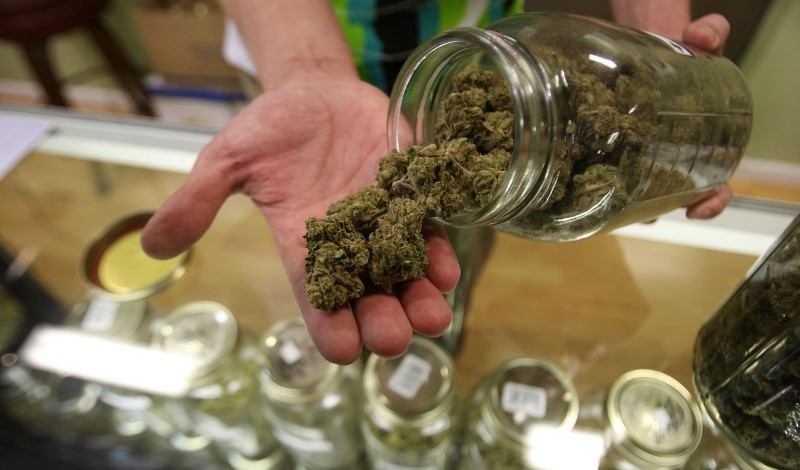
Scholar argues that licensing, financing, and banking laws prevent tribes from entering the booming cannabis industry.
The cannabis industry is projected to grow from almost $33 billion in 2023 to $49 billion by 2026. But although numerous states have legalized marijuana and lavished their economies with new business, federal law may leave Native American tribes out of the gold rush.
In a law journal article, Paul Mooney, a tribal attorney, argues that tribes attempting to enter the marijuana industry face unique barriers to entry that stymie tribes’ efforts to obtain licensing, financing, and banking necessary to start marijuana businesses.
Tribes can exercise sovereignty to license, regulate, and even legalize cannabis activities within their borders since state law generally does not apply to tribal activity on reservations. Although many states that allow recreational marijuana sale do so by issuing growing and retail licenses to applicants, some statutes exclude Native American tribes from this licensing process.
Without a clear pathway to licensure, tribes are effectively locked out of the industry, warns Mooney. A tribal grower who tries to sell cannabis to a state-licensed retailer may face prosecution for transporting cannabis off-reservation without a license, and retailers avoid purchasing from unlicensed growers to protect their own licenses. Mooney explains that marijuana has become a specialized product with an educated market demanding diverse products and strains, so without the ability to interact with third parties, tribes face the impossible task of producing everything themselves.
Mooney suggests that tribes should pursue compacts—agreements on complex legal issues between states and tribes, common in tribal casino gaming businesses—because the solutions are often more tailored to a particular tribe’s needs, even if the process is time-consuming.
Tribes could also incorporate state-chartered corporations to apply for licenses, allowing them to operate businesses off-reservation, but those tribes would lose out on special regulatory and tax benefits afforded to tribal businesses, according to Mooney.
But challenges to Native Americans entering the marijuana industry extend beyond licensing.
The marijuana industry has matured into a sophisticated economy that pushes businesses toward vertical integration, in which major operations do their own growing, processing, and retail. This shift presents a serious financial barrier to entry for tribes, and Mooney notes that the main source of funds for cannabis investment would likely come from regulated casino gaming revenue.
The Indian Gaming Regulatory Act (IGRA) restricts the use of tribal gaming revenue to five categories, including the promotion of “tribal economic development,” a term not defined in statutes, regulations, legislative history, or court records.
Mooney outlines two legal arguments that tribes may use to qualify cannabis businesses as economic development under the IGRA.
First, if a tribe can show that a statute is objectively ambiguous, then according to existing law, courts must interpret any ambiguous language to benefit Native American tribes and construe federal legislation in their favor. Mooney explains that tribes could point to the IGRA’s competing policy goals of promoting tribal economic development and preventing federally criminalized activities to argue that the statute is ambiguous.
Second, tribes within states that have legalized marijuana could also argue that state public policy on marijuana favors tribal marijuana businesses as legitimate tools for economic development. In doing so, tribes could point to the IGRA’s requirement that tribes that regulate gaming should consider state policy when developing such regulations.
Beyond financing, federal regulations also restrict access to banking in the marijuana industry, as credit unions and banks—even state-chartered banks—must submit to federal oversight to join the Federal Reserve system and gain FDIC insurance, Mooney notes.
Because the United States still lists marijuana as a Schedule I drug under the Controlled Substances Act, federal law requires banks dealing with marijuana businesses to provide extensive reports these businesses’ operations. Reporting burdens may explain why only 11 percent of banks provide services to the cannabis industry, harming prospective tribal and non-tribal business alike, Mooney suggests.
Mooney predicts that most tribes’ banks are unlikely to offer banking services for tribes engaged in marijuana business, which may push tribes to find separate banks. But because many tribes rely upon financing agreements to fund tribal businesses, terms in these agreements often prevent tribes from engaging in certain activities that could block tribal governments from using funds for marijuana businesses.
Tribes have few options to address these barriers to banking, so Mooney suggests that tribes leverage their relationships with their current banks to renegotiate financing agreements to exempt tribal cannabis businesses. He notes that tribes may have to submit to extra compliance measures and promise banks that they will not use marijuana profits to pay back loans.
Mooney emphasizes that fixing the licensing, financing, and banking barriers to entry for Native Americans would require state and local governments’ cooperation with tribes.
Indeed, some states have started to face these inequitable outcomes. For example, Michigan recently passed two laws that allow tribes to buy and sell cannabis with state-licensed businesses and establish a compacting process for regulating and taxing marijuana. Elsewhere, though, tribes—especially those in conflict with state and federal governments over oil pipelines or water rights—continue to struggle to break into the cannabis industry while retaining sovereignty.



